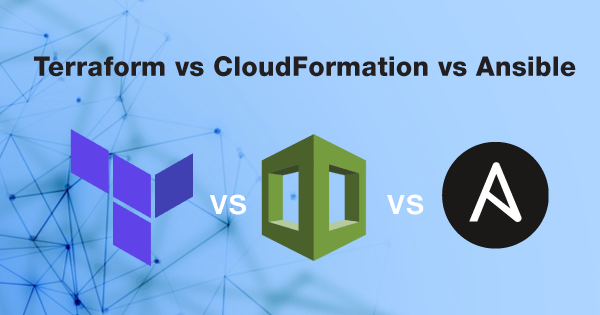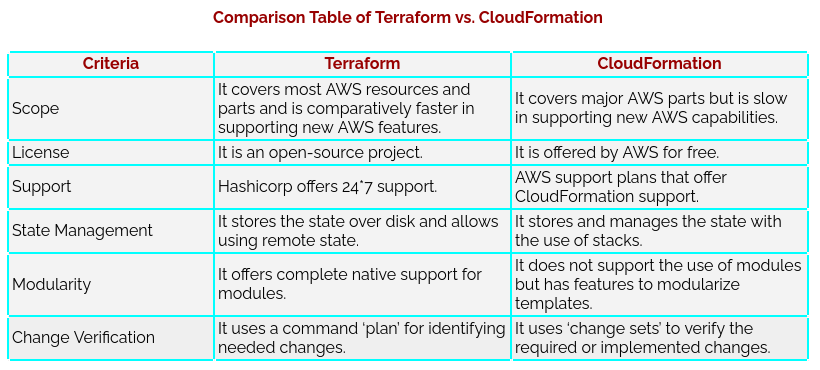Terraform is a tool that allows you to describe your infrastructure with high efficiency and convenience. But, there are other tools that offer the same functionalities for competing with Terraform, such as CloudFormation and Ansible. Therefore, it is evident to put up the comparison of Terraform vs CloudFormation vs Ansible to give you an insight about which is better among the three.
Keeping that in mind, this article is all about helping you with practical differences between these three tools for better clarity. So, follow this article to educate yourself on how each of them is different or similar to one another.
Want to read more about Terraform? Check out Terraform Tutorial here!
Terraform vs CloudFormation
In this Terraform comparison with Cloud Formation, you will get a brief insight into how both are different in terms of functionalities for your specific needs. Terraform is an open-source software tool and uses infrastructure-as-code ideology for setting up or provisioning the infrastructure. It is a cloud tool that codifies several APIs to configuration files for making it able to share with different team members. These coded APIs can be edited and versioned based upon the requirements.
CloudFormation is a managed service offered by AWS that comes with a common language for modeling and provisioning third-party app resources. It is done for your cloud platform with a single point of reference for infrastructure mapping & development. CloudFormation takes off the hassle of figuring out which services are important for being provisioned and how to connect the dependencies.
As you have now understood the practical definition of both Terraform and Cloud Formation, it is now time to give you a verdict upon Terraform vs CloudFormation. This Terraform comparison with CloudFormation will give you clarity upon the difference between the two tools in terms of selection criteria.
1. State File Format
The state file within Terraform is in JSON format, whereas CloudFormation can deal with state files of both JSON and YAML format.
2. Differences in Terms of Scope
CloudFormation is destined to cover most of the AWS parts and demands some time to support or assist new service capabilities. Terraform covers both AWS parts and resources and is faster in supporting service capabilities or AWS features as compared to CloudFormation. Moreover, Terraform also supports third party services and cloud providers.
3. License & Support
CloudFormation is offered for free under AWS, and the support plans under AWS offer ideal CloudFormation support as well. Terraform is considerably known to be an enterprise product and is an open-source project. Hashicorp offers 24*7 support for Terraform applications.
4. Management of State
Before inching to the differences in terms of state management between Terraform and CloudFormation, it is important for you to know that keeping track of all existing resources under the management portal is quite important for both tools.
CloudFormation manages its state within the stacks, whereas Terraform stores its state within the disk or a provisioning computer. Terraform is offering remote state as well, such as Terraform Cloud or S3 and DynamoDB.
5. Modularization
Terraform comes with native support for diverse modules with several open-source modules embedded within the Terraform registry. CloudFormation lacks modular support; instead, it has some special features for modularizing the templates. CloudFormation does not have any central place for sharing the templates. The export feature might allow the users to share outputs but lacks the feature of changing them.
Preparing for HashiCorp Certified Terraform Associate certification? Try our Free Test today!
6. Change Verification
This Terraform comparison with CloudFormation will put light on how change-verification varies between them. CloudFormation offers change sets that can be implemented or used for verifying the changes. But, Terraform has a specific command named ‘plan’ that is called for elaborating and highlighting a detailed overview of what changes or modifications are to be made to the infrastructure.
7. Wait Conditions
Wait conditions are often added to the infrastructure automation aspects over time. CloudFormation allows the users to enable and use wait conditions for adding several breakpoints to the existing template. But, Terraform does not offer such a feature of enabling wait conditions.
8. Handling of the Existing Resources
The resources are better handled within Terraform as compared to CloudFormation. CloudFormation can import only the existing resources for countable or fewer resource types. But, Terraform does not have such restrictions to import existing resources. Moreover, it allows data providers to query the attributes from such resources.
These are a few of the practical differences brought up under the Terraform comparison with CloudFormation. By considering all the points, you can definitely pick the right tool that meets your requirements on priority.
Try HashiCorp Certified Terraform Associate certification Practice Tests here before attempting the real exam!
Terraform vs. Ansible
Detailed information upon Terraform is given right at the beginning of this article. So, before commencing with the Terraform comparison with Ansible, here is brief information regarding Ansible.
Ansible is run by Red Hat and was launched in 2012. It is popularly known to be a configuration management tool that has an open-source nature. The architecture of Ansible is serverless and agentless. It definitely supports the modules for UNIX, Windows, and other such hosts. Ansible depends upon the PowerShell or SSH sessions for commencing with the configuration tasks.
The practical differences of different criteria that justify Terraform vs Ansible are:
1. Provisioning
Terraform lacks some important features within the declarative model for which some forms of complexities come up while implementing provisioning in selected ways. Ansible is meant to offer seamless provision over the cloud platforms, hosts, hypervisors, and servers. Hence, it is considered to be a better tool than Terraform for provisioning.
2. Configuring Cloud Infrastructures
Terraform is destined to configure the cloud infrastructures perfectly, whereas Ansible is only destined for configuring servers.
3. Deployment
Terraform results in helping the business deploy VPCs, load balancers, and others, whereas Ansible is destined to deploy apps over the top of the infrastructure.
4. Language
Terraform is considered to be following a declarative language! It is because it declares what is essential and not the process of execution directly. Terraform defines the environment, and the changes imposed upon it will be applied only in the next ‘Apply’ session. Ansible adapts the procedural language that derives the steps of achieving the end result. It can also accept the ad-hoc queries for change which do not exist in Terraform.
5. Packaging & Templating / State Management
Terraform offers partial and considerable support for templating and packaging, whereas Ansible offers complete support for the same. Terraform is majorly dependent upon the state management aspects, whereas Ansible does not have any lifecycle management ideologies.
Conclusion
These are the practical differences between Terraform, Ansible, and CloudFormation to give you a clear insight into the perks of each of these tools. Keeping these comparison points in mind will help you choose the right option as per your requirements. If you’re new to these tools, you can check out our training library and broaden your knowledge to become a pro. If you have any questions, feel free to write in the comment section below and our experts will reply in no time.
- Top 20 Questions To Prepare For Certified Kubernetes Administrator Exam - August 16, 2024
- 10 AWS Services to Master for the AWS Developer Associate Exam - August 14, 2024
- Exam Tips for AWS Machine Learning Specialty Certification - August 7, 2024
- Best 15+ AWS Developer Associate hands-on labs in 2024 - July 24, 2024
- Containers vs Virtual Machines: Differences You Should Know - June 24, 2024
- Databricks Launched World’s Most Capable Large Language Model (LLM) - April 26, 2024
- What are the storage options available in Microsoft Azure? - March 14, 2024
- User’s Guide to Getting Started with Google Kubernetes Engine - March 1, 2024





